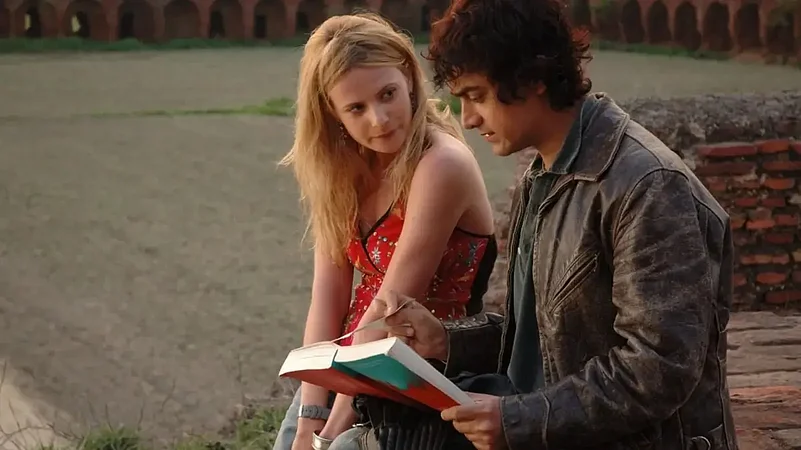Bollywood movies that take on with gusto nationalist sentiments almost always garner positive responses from the audience. While they evoke very clear feelings of patriotism with their plots, they also use their sub-plots very cleverly to aid the justification of overly melodramatic sequences. One such plot device is the white woman in Bollywood movies - badly represented for the sake of offering a contrast to the native woman. However, it does not just stop at showing the pitfalls of westernisation and the Indian woman’s ability to embrace a stiff mix of modernity with sanskaar; it also requires the Indian man’s approval of both these women.
Advertisement
The Indian man in these instances embodies the audience’s approval of the movie and in his claiming the better woman between the two lies a nod to a heavily nationalist storyline.
In most movies the white woman does not even have to be white-skinned, their promiscuity is embodied in “westernised” women. Notable examples include - Lisa Haydon in ‘Queen’, Deepika Padukone in ‘Cocktail’, and Katrina Kaif in almost all her movies.
Watching these movies would lead one to assume these women don't take any breaks from being “wild” to even do their laundry. The personification of “westernised” characteristics to display “immorality” is only to show the supposed merits and morality of living a more culturally Indian lifestyle. This contrast between two women is often not enough by itself and requires the validation of the Indian man.
Advertisement
Some of the most popular representation of a white woman in recent times comes from nationalistic movies like ‘RRR’, ‘Lagaan’ or ‘Rang De Basanti’. In these cases, the white woman on a very practical basis has no reason to side with the Indians, let alone go out of their way to help them. However, this troupe is made easy to believe not just by Bollywood's tendency to show life-changing-deep connections stemming from just two minutes of conversation between people, but also in its westernised approval of the Indian cause. In the white woman’s offering of help lies not just concurrence to the cause but also the supposed disempowerment of the white man. In this situation, a white woman is a tool used to reinforce Indian masculinity as being preferred over white masculinity.
In ‘Lagaan’, in a seemingly impossible twist of events, Elizabeth (Rachel Shelley) is in love with Bhuvan (Aamir Khan), for, what one can only assume, is his hidden likeliness to her. If this subplot was only to offer a romantic arc to the movie, which was already amply provided by the relationship between Bhuvan and Gauri (Gracy Singh), it would seem a bit redundant. However, in the larger scheme of things, Elizabeth’s help and love are crucial not just for the exaggerated Lord Krishna-Radha metaphors but also for them understanding the game and ultimately winning. It is evident in their portrayal of the importance of religion, morality and culture of a very narrow kind to the larger nationalist plot.
Advertisement
If one was to move a bit away from this narrow conception and look at ‘Rang De Basanti’, we find the white woman-Sue (Alice Patten) as a tool representing unity and morality. One can argue that her presence in the movie or her documentary on Bhagat Singh is for purely cinematic purposes, however, her position as DJ's (Aamir Khan) love interest and his approval of her is an integral part of the larger plot. She does not offer any contrast to the Indian woman- Sonia (Soha Ali Khan) in the movie, but her documentary very quickly takes a backseat, after having served the purpose of evoking revolutionary nationalistic sentiments, once she becomes attracted to DJ. As the film progresses, it seems to mostly be about Indian masculinity and their revolutionary fervour towards their nation. Towards the end of the movie, Sue is seen reminiscing on the airstrip where they all used to hang out. In the scene, Sue is not just speaking for Sonia, the Indian woman who has lost her pilot husband, but Sue is also speaking about her own experience. However, while taking up the mantel to speak for both of them, she sadly seems to put both of them in the position of an onlooker. She says little to nothing about their own contributions and perception of the tragedy.
Advertisement
Nationalistic movies almost always use women in the role of wives, mothers and sisters to further larger plot points leaving them spoken for rather than letting them speak. The white woman is a very clever additive tool to reinforce Indian masculinity while also being subordinate to the Indian woman’s cultural superiority. It is clever because it is a bad representation, but that's exactly what works and is needed for the plot.
It is like the necessary placement of vamp in all Indian daily soaps, whose evil actions make no coherence practically, but definitely makes the lead pair look great.




















